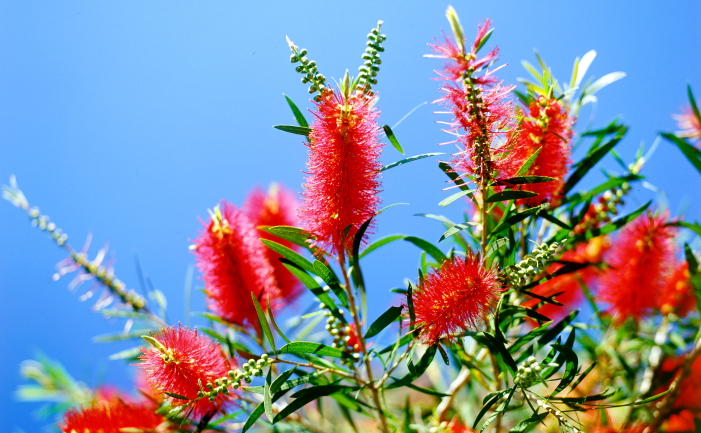Bottlebrushes (Callistemon spp.) are among the hardiest of Australian native plants.
They are long lived, require minimal maintenance and are almost impossible to kill. The flowers attract native birds, especially honey eaters, and reward the gardener with extraordinary amounts of colour. The original bottlebrushes available to gardeners were all bold red but flower colours now range from red to pink, mauve, cream and green.
Plant details
Common name: Bottlebrush. The name derives from the plant’s flowers, which look like brushes for cleaning bottles.
Botanic name: Callistemon spp. The name is derived from the Greek words kallos, meaning beauty, and stemon, meaning stamen, describing the coloured stamens, the showy part of the flowers.
Best climate: Bottlebrush grow in all but the driest areas of Australia. They need a warm spot in cool and mountain districts.
Main species
Botanic Name: C. citrinus
Common name: crimson bottlebrush
Description: A medium to large shrub to 4m high with stiff citrus scented foliage. Flowers late spring to autumn.
Best climate: Will grow in all areas of Australia. Prefers moist to wet soils.
Botanic Name: C. salignus
Common name: white bottlebrush or willow bottlebrush
Description: Small tree 4 – 10m with profuse white, cream flowers.
Best climate: Will grow in all areas of Australia, but can be frost sensative. Prefers moist to wet soils.
Botanic Name: C. viminalis
Common name: weeping bottlebrush
Description: A large shrub to 8m high with weeping foliage. Flowers late spring to autumn.
Best climate: Will grow in all areas of Australia. Prefers moist to wet soils.
Don’s Pick
C. ‘Harkness’: one of the best bottlebrushes ever, with its long lasting, spectacular display of showy red flowers. click here for a detailed fact sheet
Other Varieties
C. ‘Candy Pink’ – Medium shrub to 4m that flowers all year with large dark pink brushes.
C. ‘Captain Cook’ – Small shrub to 1.5m with abundant red brushes.
C. ‘Dawson River Weeper’ – Bright red flowering small tree to 6m.
C. ‘Endeavour’ – Hardy dense shrub 2.5m x 2.5m with long brilliant red flowers.
C. ‘Great Balls of Fire’ – 1m shrub with spectacular red new foliage that makes for a great hedge.
C. ‘Hannah Ray’ – Weeping 4-5m shrub that flowers in spring and again in Autumn.
C. ‘Hot Pink’ – Very bright pink flowering round compact shrub 1.5 – 2m.
C. ‘Kings Park Special’ – Beautiful medium sized shrub to 4m.
C. ‘Little John’ – Small shrub under 1m with grey-green foliage and dark red brushes.
C. ‘Purple Cloud’ – rounded shrub to 2m (6’7″) high by 2m (6’7″) wide with purple flowers.
C. ‘Taree Pink’ – 3m shrub with showy pink new growth in spring and pink flowers.
C. ‘White Anzac’ – 1.5m shrub with white flowers requiring pruning after flowering.
C. ‘Wildfire’ – rounded shrub to 2m (6’7″) high by 2m (6’7″) wide with slightly pendulous branches. Showy red clusters of brushy flowers.
Best look
A bottlebrush is a good addition to almost any Australian garden. They also look great as a hedge, screen plant or street tree.
Good points
• Sensational spring colour
• Extremely hardy and long lived (bottlebrush flower year after year and can live for 20 to 40 years if given the right climatic and growing conditions).
• Low maintenance
• Thrive in damp, poorly drained soils but will also take a dry spot (but do not plant in water logged soils)
• Dwarf varieties are available
• Bird attracting
Likes
full sun, moist soils
Hates
Extremely hot, dry conditions or very cold conditions (although some species and cultivars are more tolerant than others to extremes of climatic conditions)
Down side
Can become open and straggly
Care
For fertile varieties, snip off flowerheads at the base of the flower spike once the flower display has finished. This will encourage reflowering and result in a compact and attractive shrub or small garden tree. when plants become straggly, prune heavily after which new growth will flourish.
Cost and availability
Bottlebrushes are available from your local native plant nursery or one of the following specialist native plant nurseries:
NSW
Sydney Wildflower Nursery (south), 9 Veno Street, Heathcote, 2233. Phone: (02) 9548 2818.
Ozbreed, 02 4577 2977, www.ozbreed.com.au
Australian Natives, 0438 284 448, www.australian-natives.com.au
The Wildflower Place 453 The Entrance Rd, Erina Heights, phone (02) 4365 5510.
Qld
Fairhill Native Plants, Fairhill Road, Yandina, 4561. Phone: (07) 5446 7088. www.fairhillnursery.com
Nielsen’s Native Nursery 49-51 Beenleigh-Redland Bay Rd, Logan-holme, Qld 4129; (07) 3806 1414
Changers Green Nursery PO Box 2, Gin Gin, Qld 4671; (07) 4157 4283, www.nurseriesonline.com.au/changers-green
SA
Nellie Nursery, 46 Randell Street, Mannum, 5238. Phone: (08) 8569 1762.
Vic
Kuranga Native Nursery, 118 York Rd, Mt Evelyn, Vic 3796; (03) 9760 8100; www.kuranga.com.au
Vaughan’s Australian Plants 1060 Portarlington Rd, Curlewis, Vic; phone (03) 5250 5592, www.vaughansnativeplants.com
WA
Zanthorrea Nursery, 155 Watsonia Road, Maida Vale, 6057. Phone: (08) 9454 4540. www.zanthorrea.com
Lullfitz Nursery Cnr Caporn St & Honey Rd, Wanneroo, WA; (08) 9405 1607; www.lullfitz.com.au



